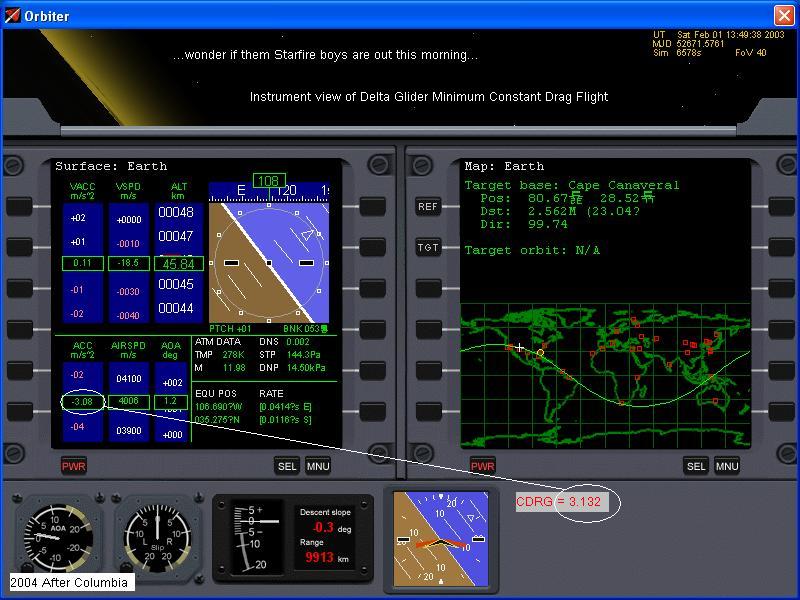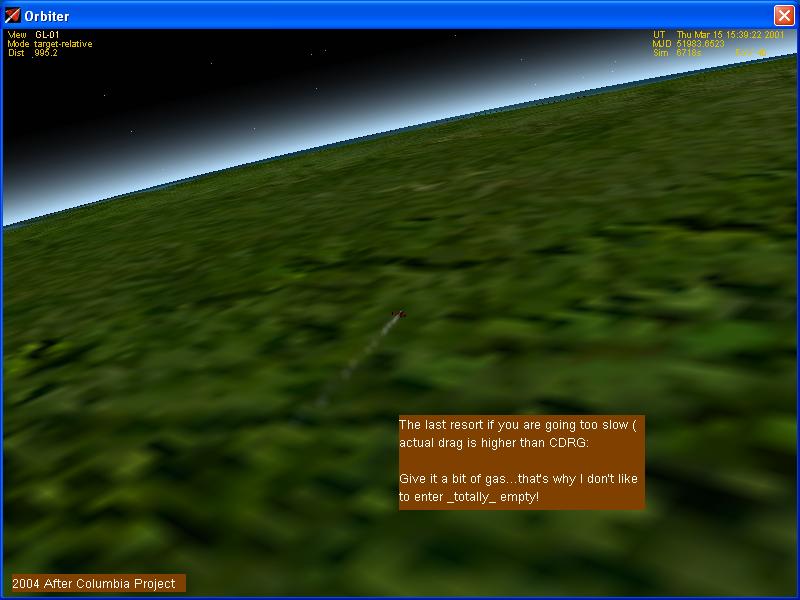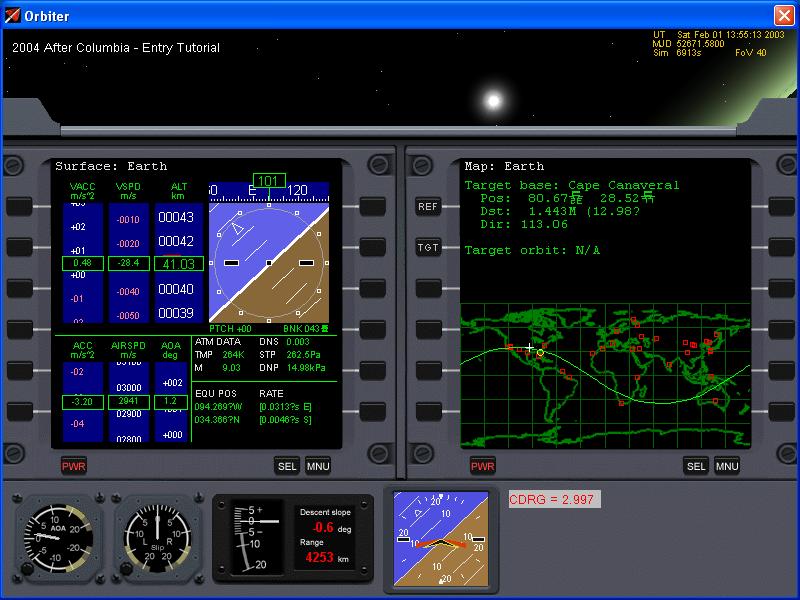The equilibrium glide phase transitions the Orbiter from the rapidly increasing drag levels of the
temperature control phase to the constant drag phase. Equilibrium flight is defined as flight in which the flight path
angle ... remains constant. Equilibrium glide flight provides the maxsimum downrange capability, and continues until
the drag acceleration reaches 33 feet per second squared [10m/s^2]
In Delta Glider, the equivalent is ramping up the drag until it reaches CDRG about 3000km from base, usually at the much
gentler rate of 3.25 to 3.50 m/s^2 (about 11 ft/s^2.) Interestingly, the forces felt by the crews not so different
because of the difference in lift over drag ratios. Delta Glider nets about 1.5g, while Shuttle gets about 2g

This situation shows what things were like after I corrected the entry using the lift reserve and elevon control.
It is impossible to take screenshots while flying that mode (I was holding Ctrl-Numpad2, and Ctrl affects the PrintScrn button.)
I usually don't fly with a joystick because in most phases of flight, it is difficult to get control consistency...especially
with my joystick.
This screenshot was taken almost immediately after I released elevon control, because I'm dropping out of the sky with
a VACC of -1.72 m/s^2 and a VSPD of -44 m/s. Normal values for this phase are a VACC of about -0.02 m/s^2, a VSPD of
-10 m/s and a DNP of about 12 kPa.
Try to stay below CDRG until your speed is below 5000m/s and and CDRG is above 3.00m/s^2
 The roll reversals become more frequent and bank angles shallower as I close in on the Cape. This shot is five
minutes after the previous one, and shows Constant Drag flight, with actual drag following the CDRG parameter. A nettlesome
problem is that the target point for this is directly over the runway at high altitude making lining up rather difficult.
It is necessary to target a spot off the end of one of the runways, after which you would turn towards the runway to line
up with it and glide to a perfect landing. Shuttle calls this the HAC intercept, which we'll get to on the next two
pages.

If you wind up short on energy, use elevon control to increase altitude and L/D ratio. If that is insufficient,
add some power. The earlier this problem is realized, the easier it is to correct and the smaller amount of propellant
is needed. The Shuttle is well above its best L/D angle of attack, so increasing altitude is impossible, and pitching
down would overheat the wing's and lead to breakup. The Shuttle flies the gentlest possible angle of attack already,
and there is little reserve (the RCC panels can withstand 3200degF or 1760degC; normal entry temperatures at
the hottest spots on the Shuttle which are just behind the shockwave interaction points located in front of
RCC panels 8 and 9 on each wing, and just happens to be where the foam struck on STS-107 on the left wing normally reach 3000degF
or 1650degC. It does not take much error in terms of maintaining attitude or altitude to make up that margin.)
The OMS are too weak, even if they could work under these circumstances; they are not aligned well with the velocity vector.
So, if you're in the Delta Glider, you have a chance under these circumstances. If you are in the Shuttle, you are screwed.
This is one of the many reasons why you have five computers, at least two of which have to fail before you are in trouble.
If there is a thermal protection breach, the resulting breakup is most likely during equilibrium drag. STS-107 lost
signal just one minute and 21 seconds prior to entering equilibrium drag, consistent with the huge hole she had
in her left wing. Varying the size of the hole all the way up to breaking off the entire RCC panel 8-left would probably
move the break up point only a minute or two; probably no further west than western New Mexico before a debris event big enough
to cause the requisite damage would be detected in real time. Making the hole smaller down to 1 square inch would likely
push the break up into the equilibrium glide. A hole of 1 square inch, or a 1.25 diameter round hole would probably
lead to break up late in the constant drag phase, which may be survivable.

This picture shows a drag adjustment in progress. VACC is positive, which means that I'm reducing my sink rate.
The reason is because the actual drag value is less than the target CDRG. I'm targeting for the northern end of the
Runway (that being Runway 15).
The constant drag phase begins at [33 f/s^2 net drag], with an initial 40 degree angle of attack,
ramping down to 36 degrees by the end of the phase.
|

